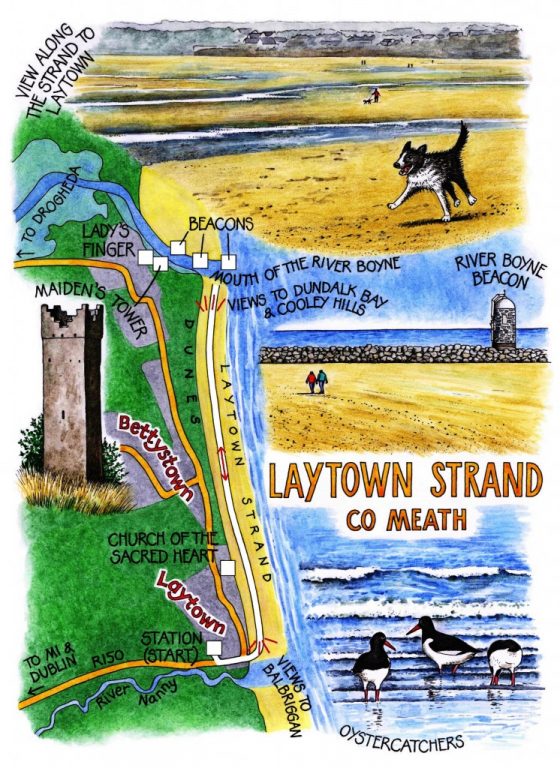 Irish Independent – WALK OF THE WEEK – Christopher Somerville
Irish Independent – WALK OF THE WEEK – Christopher Somerville
16 July 2011
104. Laytown Strand, Co. Meath
A gorgeous afternoon of clear blue sky along the coast north of Dublin, the mid-afternoon peace broken only by the squeal of excited youngsters just let out of Laytown school. From the slipway by the mouth of the River Nanny the view was enormous – south to the bulge of the promontory at Balbriggan, then all round the curve of a shoreline stretching north to the distant humps of the Cooley Peninsula 25 miles off. If ever a prospect called a walker out onto the strand, this was it.
The low sandy cliffs that bound Laytown Strand are crowned with shaggy grass and rammed into solidity with chicken-wire baskets of boulders, testament to the pounding erosive force of the Irish Sea in winter gales. Today the sea rolled flat to the eastern horizon, the low angle of the sun imparting a lazy glint to each ripple. The scene on the strand called to mind one of those Impressionist evocations of the beach at Deauville or Trouville – tiny children staggering with arms aloft for balance, lovers strolling two by two, kite flyers and ecstatically scampering dogs. Jane strode ahead in her bold scarlet windcheater, brightly lit by the westering sun.
Down on the tideline oystercatchers skimmed the wavelets with a black-and-white flash of scythe-blade wings. Curlews trilled mournfully, and dunlin ran head to wind in swiftly pattering tribes. The beach lay broad and firm, a sweep of cockle shells crunched into a trillion shards by boots, sandals, trainers and dog paws. A solitary line of horse’s hoof-prints made a ghost gallop up the beach, each horseshoe nail clearly stamped in the sand. Other than that there was nothing to hint at Laytown’s annual red-letter day each September when the great and good (and the plain and ordinary) of the racing world descend on the modest seaside resort for Laytown Races.
Was it the parish priest who initiated horse racing on the beach back in 1876? Certainly there’s been an unbroken tradition for well over a century of a once-a-year meeting, its date and timing dependent on the state of the tide. The enclosure is a humble meadow, the grandstand a set of steps let into the dunes. This is no donkey derby, however. Laytown Races is a fully professional flat racing meeting, with prize money and the pride of jockeys, owners and trainers at stake. Yet there’s something about the spectacle of the horses thundering along the strand, backgrounded by the sea and yelled on by crowds waving from the sandhills, that gives this unique meeting a carnival – if not actually a funfair – atmosphere.
We passed Laytown’s great clifftop Church of the Sacred Heart, its tall east window staring out to sea, its high wall blank and curved like the stern of a vast trawler or the blunt head of Jonah’s whale. The houses of Bettystown stepped to the edge of the cliff. Beyond them a line of dunes bleached by sun and salt marched away to vanishing point at the mouth of the River Boyne. Jane stopped by a beach pool to photograph crab shells planed as thin as tissue by the tides, the delicate exoskeletons of sea urchins and a baby flatfish of an unearthly porcelain white. A pair of rooks, bald-faced and feather-trousered, swaggered like sailors on shore leave among piles of razorshells, snapping up the shellfish in their pickaxe beaks.
At the mouth of the Boyne we stopped before turning back towards Laytown. The city of Drogheda lay hidden among hills. The north bank of the Boyne’s tideway was marked by tall old beacons, conical stone ‘men’ 30 feet high, each white-washed pate crowned with a pair of cormorants.
Just upriver, the slender lookout of the Maiden’s Tower stood paired with the stark stone phallus known as the Lady’s Finger. The legend that links these two ancient seamarks tells of a lover about to go on a voyage who promises that his ship will fly a white banner on its return if all is well, a red one if not. While he is away, his lady love builds a tower on the shore to watch for him. Catching his first sight of the tower as his ship returns, the lover assumes he is approaching a foreign coast and lets fly the red banner. The lady casts herself in despair from the tower, leaving only her finger behind.
Judging by the height of the Lady’s Finger seamark, the damsel when fully assembled must have stood some 600 feet tall in her stockings – but no taller than this poignant old tale.
WAY TO GO
MAP: OS of Ireland 1:50,000 Discovery 43
GPS: satmap.com
TRAVEL:
Rail (irishrail.ie): Laytown station
Bus (buseireann.ie): 190 from Drogheda
Road: Laytown signed from R132 Drogheda-Balbriggan road.
WALK DIRECTIONS: From Laytown station, turn left along the road to the seafront; left along Laytown Strand to mouth of River Boyne, and return.
LENGTH: 6½ miles: allow 2-3 hours
GRADE: Easy; firm sand underfoot
DON’T MISS … !
• horses exercising on the strand
• Church of the Sacred Heart, Laytown
• Maiden’s Tower and Lady’s Finger
REFRESHMENTS: Cottage Inn, Laytown (041-982-7110)
LAYTOWN RACES 2011: Thursday 8 September (info 041-984-2111)
WALKING in IRELAND: Walking tour operators, local walks including Discover Ireland’s National Loop Walks, walking festivals throughout Ireland: www.discoverireland.ie/walking.
Slieveboy Walk, Askamore, Co. Wexford: 12 noon, Sunday 24 July (contact Paddy Byrne, 087-231-0688)
BOOK: Christopher Somerville’s book Walking in Ireland (Ebury Press) contains 50 of his favourite Irish Independent walks.
INFORMATION:
Drogheda Tourist Office: West Street (041-987-2843); meath.ie/tourism
csomerville@independent.ie
(920 words)